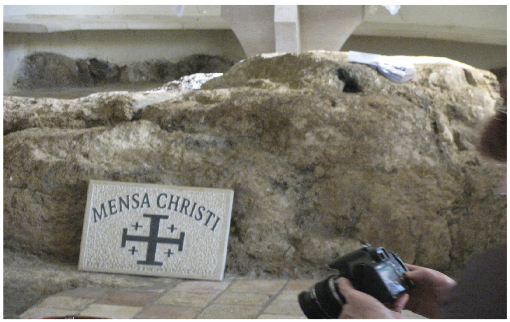
Volume 18, Issue 22 (May 29, 2016)
“On This Rock”
By Kyle Pope
If you have ever studied a foreign language you have probably found it frustrating that other languages classify words according to gender (i.e. masculine, feminine, neuter) to a greater extent than English. Unlike English, where usually only living things have gender, in other languages objects can be grammatically classified as masculine or feminine. This tendency is quite noticeable when someone from another country just learning English may confuse pronouns. They might, say “she is a beautiful day” rather than “it is a beautiful day.” While this is puzzling to those of us not accustomed to it there are times when this helps clarify meaning.

The Mensa Christi, the so-called “Table of Christ” located in a small chapel in Tabgha, Israel on the Sea of Galilee, is falsely believed by many Catholics to be where Jesus conferred upon Peter the “primacy” over the church.
The Roman Catholic church has for years looked to Matthew 16:18 in an attempt to justify having a pope as the head of its church. Recognizing that “Peter” means rock, they have tried to assert that when Jesus said “you are Peter, and on this rock I will build My church” He was declaring that Peter was the rock upon which He would build His church. In spite of the fact that the context suggests that it is Peter’s confession (that Jesus is the Christ) which is the bedrock of the church, and nothing is said about a succession of leaders resembling the papacy, our Catholic friends still claim that this justifies the papal authority upon which Catholicism is built.
Fortunately, the text offers us even more information to help us clarify this question. First, in the Greek we discover that the words translated “Peter” and “rock” are not the same. Peter is a transliteration of the word Petros, meaning, “stone” (BAGD, 654). In contrast, the word for “rock” is petra, with a feminine ending. This small change affects the meaning. Instead of referring to a smaller rock, it refers to a, “...ledge, cliff...a large stone” (Thayer, 507). This is clear in other Scriptures where the word is used. A petra is the unshakeable foundation the wise man builds upon (Matthew 7:24-25), it is the rock into which Jesus’ tomb was carved (Matthew 27:60), and it is the stony ground of the parable of the sower (Luke 8:6, 13). Second, the word translated “this” matches the feminine gender of petra. That means that it cannot be referring to Peter, but to a separate bedrock (i.e. the truth that he had just confessed).
While this evidence alone is conclusive it doesn’t satisfy all of our Catholic friends. Some argue that Matthew was originally written in Aramaic, in which the word kefa is the same in both instances. First, there is no solid evidence that Matthew was written in Aramaic. The fourth century church historian Eusebius preserves an early claim that Matthew was written in Hebrew but there is no reason to think that he confused Hebrew with Aramaic (Ecclesiastical History, 3.39). The fact is there is no manuscript evidence of a pre-Greek Matthew. Second, early translations of Matthew follow the pattern of the Greek text. In both Latin and Coptic the Greek words Petros and petra are brought into the text, with Latin and Coptic words for “this” matching the feminine gender of petra.
While it is true that Aramaic (i.e. Syriac) translations spell the words for “Peter” and “rock” the same, they actually follow the same gender pattern as the Greek text. The word kefa in Syriac is a feminine noun (Lexicon Syriacum, p.315). Like the Greek, Latin, and Coptic, in Matthew 16:18 the Syriac word for “this” is feminine. But Peter is called kefa. B. Harris Cowper, in his work Principles of Syriac Grammar tells us that in Syriac “names and appellations of men are masculine” (p. 65). When nouns are used figuratively they are treated “as of the gender of those which they represent” (95). As an example, Cowper cites the Syriac word melta, meaning “word.” Although it is at other times feminine, when it is used of Jesus it is masculine. That means that the Syriac text, like the Greek, uses a masculine word for Peter’s name and a feminine word for the foundation upon which the church is built. This is confirmed by the fact that in the Greek New Testament the name “Cephas” (drawn from the spoken Aramaic of Jesus’ day) is masculine (BAG, 431). Aramaic may not make as sharp a distinction in meaning between masculine and feminine words for rock as Greek does. Yet the fact that the Syriac maintains the gender distinction shows that Jesus is referring to something other than Peter. There is no question that Jesus used a play on words, but that is a far cry from making Peter the first pope.

